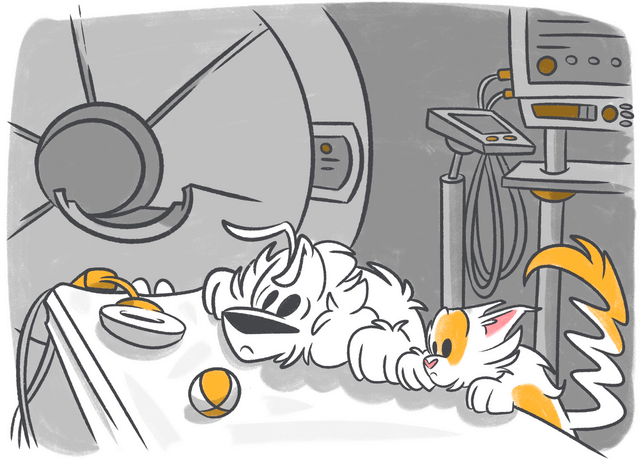When our dogs are unwell, we'd go to any length to ensure their well-being, even if it means exploring advanced diagnostic tools like MRI. Magnetic Resonance Imaging (MRI) has become a cornerstone in veterinary medicine for its precise, in-depth look into our pets' health issues without the need for invasive procedures.
Dr. Susan Kraft and veterinary radiologist, Dr. Jimmy C. Lattimer, leading experts in veterinary MRI, share their insights into the significance and application of MRI for dogs, offering peace of mind to worried pet parents. From understanding the basics to navigating the considerations and costs involved, this guide is your comprehensive resource on everything related to dog MRIs.
Stop Googling - Ask a Real Vet
Content:
What Is an MRI
An MRI, or Magnetic Resonance Imaging, is like a super-powered camera that takes incredibly detailed pictures of your dog’s insides. Using a giant magnet and radio waves (no x-rays here!), an MRI scans your pet's body to create images that show everything from bones to organs in great detail. This is super helpful for diagnosing tricky health issues, especially those hidden deep inside.
"MRIs bring a revolutionary perspective to veterinary diagnostics, allowing us to visualize internal structures in ways we could only imagine before," explains Dr. Lattimer.
Unlike x-rays, which are great for looking at bones, MRIs are the go-to for checking out soft tissues—think brains, spinal cords, and ligaments. It's a non-invasive way to get a good look at what’s going on inside, helping vets pinpoint problems like tumors, injuries, and brain disorders without having to perform surgery just to take a peek.
Considering an MRI for your pet can be a bit worrying, not just health-wise but also thinking about how to keep them calm during the scan. To help with that, keeping an eye on them with a Petcube Pet Camera can be a real stress-reliever. It lets you watch over your dog and make sure they’re doing okay before and after the procedure, giving you one less thing to worry about.
How Much Is an MRI for a Dog
One of the first questions on every pet owner's mind when an MRI is suggested is, "How much is this going to cost?" It's a fair question, given that MRIs are known for being on the pricier side of diagnostics.
The cost of an MRI for your dog can vary widely, typically ranging anywhere from $1,500 to $2,500, and sometimes even more. This price can depend on several factors, including the complexity of the scan, the part of the body being imaged, and your location. Some procedures may require your dog to be anesthetized, which can add to the overall cost.
Why the hefty price tag? MRIs involve sophisticated equipment and highly trained professionals. The machine itself is a technological marvel, and the detailed images it provides are invaluable in diagnosing your pet's condition accurately.
Facing an unexpected MRI bill can be daunting, but that’s where the Petcube Emergency Fund comes in. It offers up to $3,000 in coverage for emergency vet bills for up to 6 pets on one subscription, costing around $1 a day. This can be a lifesaver when you’re faced with sudden medical expenses.
Plus, you get 24/7 access to online vet consultations, adding an extra layer of support when you need it most. And for Petcube blog readers, there’s a special 27% discount available right here, making it even easier to ensure your pet’s health and safety.
How Long Does an MRI for a Dog Take
If your vet has recommended an MRI for your pup, you might be wondering about the time commitment. After all, keeping your pet calm and comfortable before, during, and after the procedure is a top priority.
Generally, an MRI for a dog can take anywhere from 30 minutes to two hours. This timeframe depends on a few key factors, including the type of scan being performed and the specific area of your dog's body being imaged. Some scans are quick and straightforward, while others, especially those requiring detailed images of complex areas, take longer to ensure every detail is captured accurately.
Before the MRI itself, there’s a bit of prep involved. Your dog will likely need to be given anesthesia to keep them still during the scan, ensuring clear images are obtained. This means there’s also some pre-anesthetic preparation, such as fasting, and post-scan recovery time to consider. All in, you might be looking at a few hours at the vet's office or animal hospital.
It’s important to remember that while the process might sound a bit lengthy, it’s all about making sure your pet gets the best possible care. The detailed information from an MRI can be crucial in diagnosing your pet’s condition accurately and crafting a treatment plan that offers them the best chance at a full recovery.
FAQs
How long does an MRI for a dog last?
The duration of an MRI scan for a dog typically ranges between 30 minutes to two hours. The exact time can vary based on the complexity of the scan and the specific area being examined. Including preparation and recovery from anesthesia, the entire process might take several hours, but the actual time inside the MRI machine is much shorter.
How long does it take to get your dog's MRI results?
After the MRI scan is completed, the wait for results can vary. In many cases, preliminary findings can be discussed within a day, but a detailed analysis might take a bit longer—usually a few days up to a week. The timing depends on the complexity of the images, the need for a specialist's review, and the veterinary practice's workload. Your vet will keep you updated on when you can expect results and the next steps for your dog's care.
Conclusion
An MRI scan for your dog is a sophisticated diagnostic tool that provides invaluable insights into their health. While the process might seem daunting at first, understanding the duration of the scan, the preparation involved, and the timeline for results can help ease your concerns. Remember, this advanced technology is a powerful ally in diagnosing and treating your pet, ensuring they get the best possible care for a healthy and happy life.
Was this article helpful?
Help us make our articles even better










